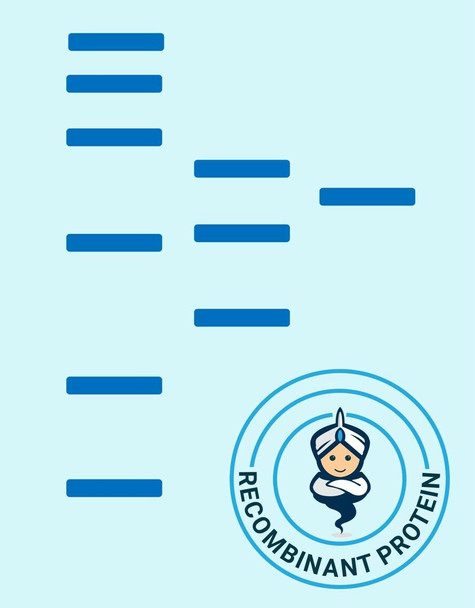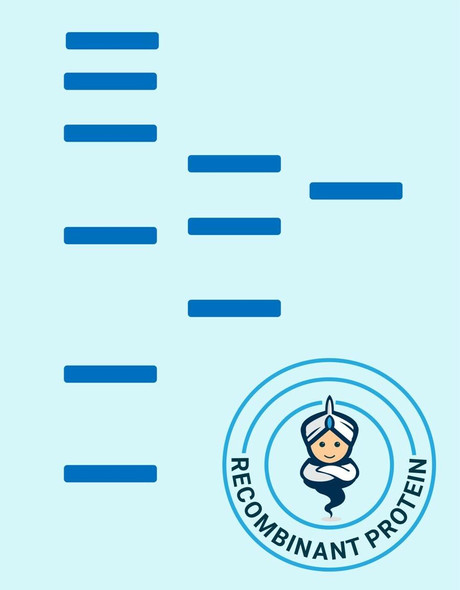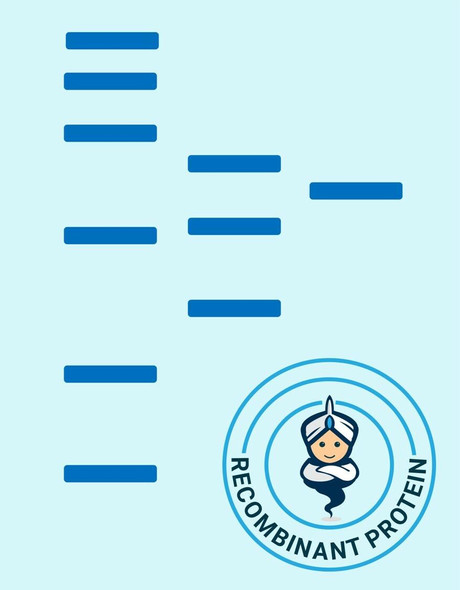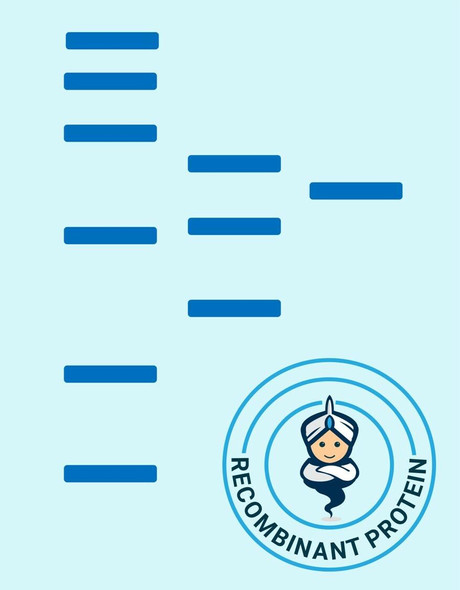Description
| Product Name: | Human GARS Recombinant Protein |
| Product Code: | RPPB1658 |
| Size: | 10µg |
| Species: | Human |
| Target: | GARS |
| Synonyms: | Glycine--tRNA ligase, Diadenosine tetraphosphate synthetase, AP-4-A synthetase, Glycyl-tRNA synthetase, GlyRS, GARS, CMT2D, DSMAV, HMN5, SMAD1. |
| Source: | Escherichia Coli |
| Physical Appearance: | Sterile Filtered colorless solution. |
| Formulation: | GARS protein solution (0. 5mg/ml) containing 20mM Tris-HCl buffer (pH 8.0), 0.15M NaCl, 10% glycerol and 1mM DTT. |
| Stability: | Store at 4°C if entire vial will be used within 2-4 weeks. Store, frozen at -20°C for longer periods of time. For long term storage it is recommended to add a carrier protein (0.1% HSA or BSA).Avoid multiple freeze-thaw cycles. |
| Purity: | Greater than 85.0% as determined by SDS-PAGE. |
| Amino Acid Sequence: | MGSSHHHHHH SSGLVPRGSH MGSPISLPAA ASRSSMDGAG AEEVLAPLRL AVRQQGDLVR KLKEDKAPQV DVDKAVAELK ARKRVLEAKE LALQPKDDIV DRAKMEDTLK RRFFYDQAFA IYGGVSGLYD FGPVGCALKN NIIQTWRQHF IQEEQILEID CTMLTPEPVL KTSGHVDKFA DFMVKDVKNG ECFRADHLLK AHLQKLMSDK KCSVEKKSEM ESVLAQLDNY GQQELADLFV NYNVKSPITG NDLSPPVSFN LMFKTFIGPG |
GARS is an (alpha)2 dimer which is a member of the class II family of tRNA synthetases. GARS is a glycyl-tRNA synthetase, one of the aminoacyl-tRNA synthetases which charge tRNAs with their cognate amino acids. GARS catalyzes the attachment of glycine to tRNA(Gly). In addition, GARS is able to produce diadenosine tetraphosphate (Ap4A), which is a universal pleiotropic signaling molecule required for cell regulation pathways, by direct condensation of two ATPs. GARS has been demonstrated to be a target of autoantibodies in the human autoimmune diseases, polymyositis or dermatomyositis.
GARS Human Recombinant produced in E.Coli is a single, non-glycosylated polypeptide chain containing 270 amino acids (43-289 a.a) and having a molecular mass of 30kDa.GARS is fused to a 23 amino acid His-tag at N-terminus & purified by proprietary chromatographic techniques.
| UniProt Protein Function: | GARS: Catalyzes the attachment of glycine to tRNA(Gly). Is also able produce diadenosine tetraphosphate (Ap4A), a universal pleiotropic signaling molecule needed for cell regulation pathways, by direct condensation of 2 ATPs. Defects in GARS are the cause of Charcot-Marie-Tooth disease type 2D (CMT2D). CMT2D is a form of Charcot- Marie-Tooth disease, the most common inherited disorder of the peripheral nervous system. Charcot-Marie-Tooth disease is classified in two main groups on the basis of electrophysiologic properties and histopathology: primary peripheral demyelinating neuropathy or CMT1, and primary peripheral axonal neuropathy or CMT2. Neuropathies of the CMT2 group are characterized by signs of axonal regeneration in the absence of obvious myelin alterations, normal or slightly reduced nerve conduction velocities, and progressive distal muscle weakness and atrophy. CMT2D is characterized by a more severe phenotype in the upper extremities (severe weakness and atrophy, absence of tendon reflexes) than in the lower limbs. CMT2D inheritance is autosomal dominant. Defects in GARS are a cause of distal hereditary motor neuronopathy type 5A (HMN5A); also known as distal hereditary motor neuropathy type V (DSMAV). A disorder characterized by distal muscular atrophy mainly affecting the upper extremities, in contrast to other distal motor neuronopathies. These constitute a heterogeneous group of neuromuscular diseases caused by selective degeneration of motor neurons in the anterior horn of the spinal cord, without sensory deficit in the posterior horn. The overall clinical picture consists of a classical distal muscular atrophy syndrome in the legs without clinical sensory loss. The disease starts with weakness and wasting of distal muscles of the anterior tibial and peroneal compartments of the legs. Later on, weakness and atrophy may expand to the proximal muscles of the lower limbs and/or to the distal upper limbs. Belongs to the class-II aminoacyl-tRNA synthetase family. |
| UniProt Protein Details: | Protein type:Mitochondrial; EC 6.1.1.14; Ligase; Translation Chromosomal Location of Human Ortholog: 7p15 Cellular Component: nucleoplasm; mitochondrial matrix; cytoplasm; cytosol; secretory granule Molecular Function:protein dimerization activity; glycine-tRNA ligase activity; ATP binding Biological Process: tRNA aminoacylation for protein translation; glycyl-tRNA aminoacylation; gene expression; diadenosine tetraphosphate biosynthetic process Disease: Neuronopathy, Distal Hereditary Motor, Type Va; Charcot-marie-tooth Disease, Axonal, Type 2d |
| NCBI Summary: | This gene encodes glycyl-tRNA synthetase, one of the aminoacyl-tRNA synthetases that charge tRNAs with their cognate amino acids. The encoded enzyme is an (alpha)2 dimer which belongs to the class II family of tRNA synthetases. It has been shown to be a target of autoantibodies in the human autoimmune diseases, polymyositis or dermatomyositis. [provided by RefSeq, Jul 2008] |
| UniProt Code: | P41250 |
| NCBI GenInfo Identifier: | 313104283 |
| NCBI Gene ID: | 2617 |
| NCBI Accession: | P41250.3 |
| UniProt Secondary Accession: | P41250,Q969Y1, B3KQA2, B4DIA0, |
| UniProt Related Accession: | P41250 |
| Molecular Weight: | 739 |
| NCBI Full Name: | Glycine--tRNA ligase |
| NCBI Synonym Full Names: | glycyl-tRNA synthetase |
| NCBI Official Symbol: | GARS�� |
| NCBI Official Synonym Symbols: | HMN5; CMT2D; DSMAV; GlyRS; SMAD1�� |
| NCBI Protein Information: | glycine--tRNA ligase; AP-4-A synthetase; glycine tRNA ligase; Charcot-Marie-Tooth neuropathy 2D; diadenosine tetraphosphate synthetase; Charcot-Marie-Tooth neuropathy, neuronal type, D |
| UniProt Protein Name: | Glycine--tRNA ligase |
| UniProt Synonym Protein Names: | Diadenosine tetraphosphate synthetase; AP-4-A synthetase; Glycyl-tRNA synthetase; GlyRS |
| Protein Family: | Glycine--tRNA ligase |
| UniProt Gene Name: | GARS�� |
| UniProt Entry Name: | SYG_HUMAN |









